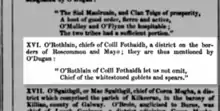Ó Rothláin
Ó Rothláin (/oʊ ˈroʊlɔːn/ oh-ROH-lawn) is an Irish surname. The name is a Patronym meaning "descendant of Rothlán." It is suggested that it is a possible variant of Ó Raghalláin, or Ó Roghallaigh.[1] It is the pre-anglicised, Irish form of the names Rowlan, Rowland, Rowlands, Rollan, Rollin, Rolan and Rowley.[2][3] The name can also be found spelled as Ó Rothlán, Ó Rothlain, O'Rothlain, Rothlán, and Rothlan.[4][5][6]
| Ó Rothláin | |
|---|---|
 Map of Connacht, c. 10th century | |
| Parent family | Uí Fiachrach |
| Place of origin | Connacht, Ireland |
| Titles | Chieftains of the Principality of Coolcarney |


Overview
The Ó Rothláin families have a strong link with County Mayo, and Country Sligo in the province of Connacht, and belong to the Uí Fiachrach.[7][8] Historically, the family held the role of chieftain (titled as "Taoiseach").[9][10][11][12]
Chieftains of the Principality of Coolcarney
Dubhaltach Mac Fhirbhisigh states in a poem written in 1417 that, Coolcarney "embraced the territory between Beel Lasa (or Foxford) and the Brosnach river in Castleconnor."[13] William Gregory Wood-Martin wrote that the family territory included Cluain na gCliabhrach (agnlicised as Cloonagleavragh).[14] Mac Fhirbhisigh describes "O'Rothlain the Ready" as one of four chieftains in Coolcarney and states that they were a "festive party."[15] Of Coolcarney John O'Donovan stated:
"These are it’s [sic] hereditary tribes, namely, O’Rothlain it’s chieftain, and Ua Cuinn, Ua Iarnain, and Ua Finain.”[16]
References in Irish Annals and scholarly works
Various members of the Ó Rothláin sept are recorded in The Tribes, Customs and Genealogies of the Hy Fiachrach by O'Donovan.[17]
- The earliest reference is found in Irish Annals dating back to 1208. According to the Annals of the Four Masters, Auliffe (also spelled "Awlave") O'Rothlain, Chief of Calry of Coolcarney, was slain by O'Moran.[18]
- The name Ó Rothláin appears again in the year 1337 in the Annals of Connacht (Annála Connacht),1337.9, stating that, "Master Ó Rothlain rested in Christ."[19] This same event again appears in the Annals of the Four Masters, M1337.3, "The Master Professor Ó Rothlain died."[20]
- In 1340, during the reign of Edward III of England, it is stated that “O’Rothlain, chiefs of Coill Fothaidh, a district on the borders of Roscommon and Mayo; they are thus mentioned by O’Dugan: ‘O’Rothlain of Coill Fothaidh let us not omit, Chief of the whitestoned goblets and spears.’”[21]
See also
References
- "Ó Rothláin - Irish Names and Surnames". www.libraryireland.com. Retrieved 6 May 2019.
- "Flann O'Riain", Townlands of Leinster and the people who lived there, Open Air, 2000, retrieved 2 February 2011
- Society, Irish Archaeological (1844). The Irish Archaeological Society.
- Publications. 1844. pp. 171–.
- Irish Pedigrees: Or, The Origin and Stem of the Irish Nation. J. Duffy and Company. 1892. pp. 571–.
- Donahoe's Magazine. T.B. Noonan. 1 January 1880.
- The Irish Archaeological Society. A chorographical description of West or H-Iar Connaught, written A.D. 1684. (https://books.google.com/books?id=ywIGAAAAQAAJ&pg=PA145&dq=o%27rothlain&ei=DNo6S6eyFZDYNoTd6aMB&cd=8#v=onepage&q=o%27rothlain&f=false)
- "The Topographical Poems of John O'Dugan". clanmaclochlainn.com. Retrieved 9 May 2019.
- O'Clery, Michael (1 January 1845). The annals of Ireland, tr. from the orig. Irish of the Four masters by O. Connellan.
- Knox, Hubert Thomas (1 January 1908). The history of the county of Mayo to the close of the sixteenth century. Judges. Figgis & Co., Ltd.
- Skene, William Forbes (1 January 1880). Celtic Scotland: A History of Ancient Alban. Edmonston & Douglas.
- The Topographical Poems of John O'Dubhagain and Giolla-na-naomh O'Huidhrin: Edited in the original Irish from MSS. in the Library of the Royal Irish Academy, Dublin, with translation, notes, and introductory dissertations, by John O'Donovan. A. Thom. 1862.
- "The Ecclesiastical History of the Parish of Attymass" (PDF). Attymass Historical Document Archive.
- Wood-Martin, William Gregory (1990). From the earliest ages to the close of the reign of Queen Elizabeth. Dodd's Antiquarian Books.
- Society, Irish Archaeological (1844). The Irish Archaeological Society.
- O'Donovan, John (1849). Miscellany of the Celtic Society. The Genealogy of Corca Laidhe; Poem on the Battle of Dun; by Gilla-Brighde Mac Conmidhe; Docwra's Tracts; Several Poems, Pedigrees, and Extracts. (celtice Et Angl.). Celtic Society. p. 31.
o'rothlain.
- O'Donovan, John (1 June 1993). Genealogies, Tribes & Customs of Hy-Fiachrach: Commonly Called O'Dowda's Country. Irish Roots Cafe. ISBN 9780940134386.
- Annals of the Four Masters. M1208.10. (http://www.ucc.ie/celt/published/T100005C/index.html)
- Annála Connacht. (http://www.ucc.ie/celt/published/T100011/)
- Annals of the Four Masters. M1337.3 (http://www.ucc.ie/celt/published/T100005C/index.html)
- O'Cleary, Michael (2003). The Annals of Ireland by the Four Masters: Translated Into English by Owen Connellan. Irish Roots Cafe. ISBN 9780940134775.